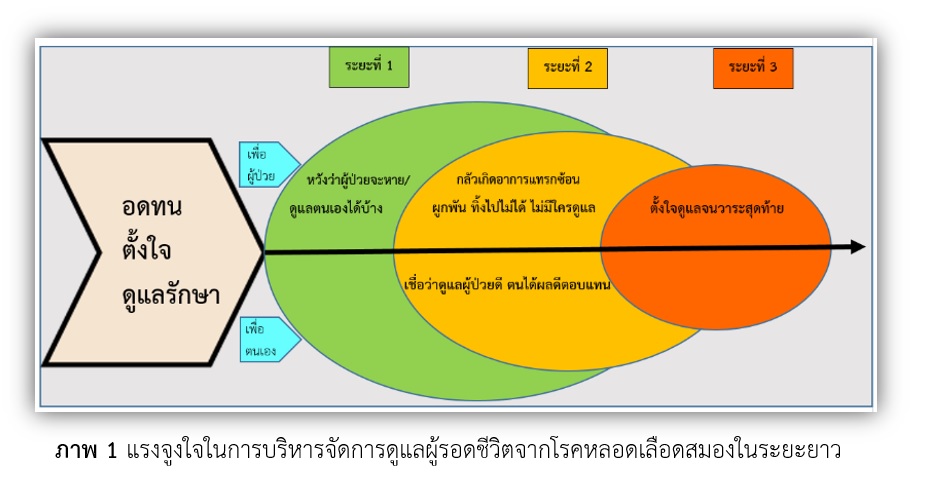แรงจูงใจในการบริหารจัดการดูแลผู้รอดชีวิตจากโรคหลอดเลือดสมอง ในระยะยาว ของผู้ดูแลในเขตอำเภอหนึ่งของจังหวัดชายแดนใต้
คำสำคัญ:
แรงจูงใจ, ผู้ดูแล, โรคหลอดเลือดสมอง, การบริหารจัดการดูแลระยะยาว, การวิจัยแบบวิธีวิทยาการสร้างทฤษฎีฐานรากบทคัดย่อ
การวิจัยเชิงคุณภาพแบบวิธีวิทยาการสร้างทฤษฎีฐานรากแบบสเตราส์ (Straussian Grounded Theory Approach) มีวัตถุประสงค์เพื่ออธิบายแรงจูงใจในการบริหารจัดการดูแลผู้รอดชีวิตจากโรคหลอดเลือดสมองในระยะยาวของผู้ดูแลในเขตอำเภอหนึ่งของจังหวัดชายแดนใต้ จากกลุ่มตัวอย่างที่มีประสบการณ์การดูแลผู้รอดชีวิตจากโรคหลอดเลือดสมองอย่างน้อยวันละ 4 ชั่วโมง เป็นระยะเวลาที่ต่อเนื่องตั้งแต่ 6 เดือนขึ้นไป และอาศัยอยู่ในตำบลหรือเขตเทศบาลของอำเภอแห่งหนึ่งในจังหวัดชายแดนใต้ จำนวน 15 คน เก็บรวบรวมข้อมูลโดย การสัมภาษณ์เชิงลึกพร้อมบันทึกเทป ร่วมกับการสังเกตแบบไม่มีส่วนร่วม และการบันทึกภาคสนาม เพื่อให้เกิดการตรวจสอบแบบสามเส้าด้านวิธีรวบรวมข้อมูล (Methodological Triangulation) วิเคราะห์ข้อมูลด้วยเทคนิคการกำหนดรหัส (Coding Analysis) ผลการวิจัยพบว่า
ผู้ดูแลมีแรงจูงใจสำคัญ ในการบริหารจัดการดูแลผู้รอดชีวิตจากโรคหลอดเลือดสมอง ตลอดการเจ็บป่วยใน 2 ลักษณะ คือ ความอดทน ตั้งใจดูแลรักษา เป็นปัจจัยพื้นฐานสำคัญที่กระตุ้นให้ผู้ดูแลมีแรงจูงใจในการบริหารจัดการดูแลผู้ป่วยตลอดระยะเวลาที่ผู้ป่วยยังมีชีวิตอยู่ และแรงจูงใจที่ผู้ดูแลพัฒนาขึ้นเพื่อเผชิญกับสถานการณ์ความเจ็บป่วยของผู้ป่วยเฉพาะในแต่ละระยะ 3 ระยะ ประกอบด้วย ระยะที่ 1 คือ หวังว่าผู้ป่วยจะหาย/ดูแลตนเองได้บ้าง ผลักดันให้ผู้ดูแลพยายามดูแลผู้ป่วยที่ ช่วยเหลือตนเองได้น้อย/ไม่ได้ ให้ฟื้นหาย/มีอาการดีขึ้น ระยะที่ 2 คือ กลัวเกิดอาการแทรกซ้อน ผูกพัน ทิ้งไปไม่ได้ ไม่มีใครดูแล และเชื่อว่าดูแลผู้ป่วยดี ตนได้ผลดีตอบแทน จูงใจให้ผู้ดูแลพยายามช่วยเหลือผู้ป่วยที่ อาการทรง ๆ ทรุด ๆ โอกาสหายเป็นปกติไม่มี ให้ฟื้นฟูสภาพตนเองอย่างต่อเนื่อง เพื่อให้ทรงอาการที่ดีขึ้นแล้วไว้ในระดับนั้น ๆ ให้นานที่สุด และระยะที่ 3 คือ ตั้งใจดูแลจนวาระสุดท้าย ส่งเสริมให้ผู้ดูแลพยายามดูแลรักษาผู้ป่วยที่ หมดหวัง หมดหนทางรักษา ตามสภาพอาการ ให้เกิดความสุขสบายเท่าที่ตนจะทำได้
ผลการศึกษาสามารถให้แนวทางแก่ผู้บริหารและผู้ปฏิบัติการพยาบาลในการบริหารจัดการดูแลผู้รอดชีวิตจากโรคหลอดเลือดสมอง ผู้ดูแล และครอบครัว ที่สอดคล้องกับแรงจูงใจพื้นฐานและแรงจูงใจในการดูแลที่เปลี่ยนแปลงไปในแต่ละระยะอย่างต่อเนื่อง ตลอดการเจ็บป่วยของผู้ป่วย
เอกสารอ้างอิง
Abdullah, T. (2015). The Effect of Endurance. Retrieved November 3, 2019 from https://www.islammore.com/main/content.php?page=sub&category=6&id=903
Aekuwetchakul, S. (2013). Development of the Community Participatory Palliative Care for Stroke Survivors in Primary Care Network, Khon Kean Hospital. (Master of Nursing Science in Community Health Nurse Practitioner thesis), Khon Kean University, Khon Kean, Thailand. Retrieved November 3, 2019 from https://tdc.thailis.or.th/tdc/search_ result.php
At-Tuayjary, M. B. I. (2015). Key to Rissiski. Retrieved November 3, 2019 from https://www.islammore.com/view/1083
Cecil, R., Thompson, K., Parahoo, K., & McCaughan, E. (2013). Towards an Understanding of the Lives of Families Affected by Stroke: A Qualitative Study of Home Carers. Journal of Advanced Nursing, 69(8), 1761-1770.
Charoenwuttimakorn, P. (2012). Factors Related to Preparedness for Caregiving among Caregivers of Patients with Ischemic Stroke. (Master of Nursing Science in Adult Nursing Thesis), Burapha University, Chon Buri, Thailand. Retrieved November 3, 2019 from https://tdc.thailis.or.th/tdc/search_result.php
Corbin, J., & Strauss, A. (2008). Basics of Qualitative Research: Techniques and Procedures for Developing Grounded Theory (3rd ed.). Thousand Oaks, CA: Sage Publications.
De Palva, R. S., Valadares, G. V., & Pontes, J. S. (2012). The Need to Become Family Caregivers: Grounded Theory. Online Brazilian Journal of Nursing, 11(3), 607-620.
Department of Religious Affairs, M. o. C. (2014). Basic Religion Facts (Vol. 2). Bangkok, BKK: Agricultural Cooperative Printing of Thailand co., Ltd.
Hesamzadeh, A., Dalvandi, A., Maddah, S. B., Khoshknab, M. F., & Ahmadi, F. (2016). Family Caregivers’ Experiences of Stroke Recovery among Older Adults Living in Iran: A Qualitative Study. Iranian Red Crescent Medical Journal, (In Press), e27686. Retrieved November 3, 2019 from https://ircmj.portal.tools/?page=article&article_id=27686
Hongsoi, S. (2012). Effects of Program for Promoting Caregiver's Ability in Continuing Care on Caregiver's Ability, Functional Ability, and Complications in Ischemic Stroke Patients. (Master of Nursing Science in Adult Nursing Thesis), Burapha University, Chon Buri, Thailand. Retrieved from https://tdc.thailis.or.th/tdc/search_result.php
Islamic Economics. (2018). Does Riske Mean Money Only? Retrieved November 3, 2019 from https://islamhouse.muslimthaipost.com/main/index.php?page=sub&category=7&id=21603
Japakiya, I. L. (2012). Patient Handbook and Management According to Islamic Principles. In Author (Ed.). Retrieved November 3, 2019 from https://www.icenter.or.th/book /detail/65
Kaewpralad, O. (2009). The Study of Family-Centered Continuing Care in First Stroke Patients. (Master of Nursing Science in Community Nurse Practitioner Thesis), Huachiew Chalermprakiet University, Samut Prakan, Thailand. Retrieved November 3, 2019 from https://tdc.thailis.or.th/tdc/search_result.php
Krishnan, S., Pappadis, M. R., Weller, S. C., Stearnes, M., Kumar, A., Ottenbacher, K. J., & Reistetter, T. A. (2017). Needs of Stroke Survivors As Perceived by Their Caregivers: A Scoping Review. American Journal of Physical Medicine & Rehabilitation, 96(7), 487-505.
Kulsawet, S. (2014). Effectiveness of Implementing Home-Based Exercise Nursing Practice Guidelines for Stroke Patient Rehabilitation in Community, Namjo Sub-District, Mae Tha District, Lampang Province. (Master of Nursing Science in Community Nurse Practitioner Thesis), Chiang Mai University, Chiang Mai, Thailand. Retrieved November 3, 2019 from https://tdc.thailis.or.th/tdc/search_result.php
Lee, R. L. T., & Mok, E. S. B. (2011). Seeking Harmony in the Provision of Care to the Stroke-Impaired: Views of Chinese family Caregivers. Journal of Clinical Nursing, 20(9/10), 1436-1444. doi:10.1111/j.1365-2702.2010.03500.x
Lo´Pez-Espuela, F., Gonza´Lez-Gil, T., Amarilla-Donoso, J., CordovillaGuardia, S., Portilla-Cuenca, J. C., & Casado-Naranjo, I. (2018). Critical Points in the Experience of Spouse Caregivers of Patients Who Have Suffered a Stroke: A Phenomenological Interpretive Study. PLoS ONE, 13(4), e0195190. Retrieved from https://doi.org/10.1371/journal.pone.0195190
Lutz, B. J., & Camicia, M. (2016). Supporting the Needs of Stroke Caregivers Across the Care Continuum. JCOM, 23(12), 557-566.
Lutz, B. J., Young, M. E., Creasy, K. R., Martz, C., Eisenbrandt, L., Brunny, J. N., & Cook, C. (2017). Improving Stroke Caregiver Readiness for Transition from Inpatient Rehabilitation to Home. Gerontologist, 57(5), 880-889. doi:10.1093/geront/gnw135
Moeller, D., & Carpenter, C. (2013). Factors Affecting Quality of Life for People Who Have Experienced a Stroke. International Journal of Therapy & Rehabilitation, 20(4), 207-216.
Nikomrack, W. (2013). Development of Continuing Care Service System for Families with Stroke Patient. (Master of Nursing Science in Family Nursing Thesis), Khon Kaen University, Khon Kaen, Thailand. Retrieved November 3, 2019 from https://tdc.thailis.or.th/tdc /search_result.php
Pesantes, M. A., Brandt, L. R., Ipince, A., Miranda, J. J., & Diez-Canseco, F. (2017). An Exploration Into Caring for a Stroke-Survivor in Lima, Peru: Emotionalimpact, Stress Factors, Coping Mechanisms and Unmet Needs of Informal Caregivers. eNeurologicalSci, 6, 33-50. Retrieved from https://dx.doi.org/10.1016/j.ensci.2016.11.004
Pitthayapong, S., Thiangtam, W., Powwattana, A., Leelacharas, S., & Waters, C. M. (2017). A Community Based Program for Family Caregivers for Post Stroke Survivors in Thailand. Asian Nursing Research, 11, 150-157. doi:org/10.1016/j.anr.2017.05.009
Prayadsup, P. (2013). Endurance Path to Heaven. Retrieved from https://www.islammore.com /view/3147
Qiu, X., Sit, J. W. H., & Koo, F. K. (2018). The Influence of Chinese Culture on Family Caregivers of Stroke Survivors: A Qualitative Study. J Clin Nurs, 27, e309-e319. Retrieved November 3, 2019 from https://onlinelibrary.wiley.com/doi/epdf/10.1111/jocn.13947
Siriratruangsuk, R., & Phadung, N. (2012). Dhrama Book: Miracle of Merit. Songkhla: Blue Image Co., Ltd.
Social Medicine Department. (2015). Process for Practices of Home Health Care Center. Yala Regional Hospital.
Sweeny, K., & Dooley, M. D. (2017). The Surprising Upsides of Worry. Social and Personality Psychology Compass, 11(4). doi:org/10.1111/spc3.12311
Wikipedia Free Encyclopedia. (2015). Yala Province. Retrieved November 3, 2019 from https://th.wikipedia.org/wiki/
Young, M. E., Lutz, B. J., Creasy, K. R., Cox, K. J., & Martz, C. (2016). A Comprehensive Assessment of Family Caregivers of Stroke Survivors During Inpatient Rehabilitation. Disabil Rehabil, 36(22), 1892–1902. Retrieved from https://www.ncbi.nlm.nih.gov /pmc/articles/PMC4959419/
Zhang, J., & Lee, D. T. F. (2017). Meaning in Stroke Family Caregiving: A Literature Review. Geriatric Nursing, 38(1), 48-56. doi:org/10.1016/j.gerinurse.2016.07.005

ดาวน์โหลด
เผยแพร่แล้ว
ฉบับ
ประเภทบทความ
สัญญาอนุญาต
1. บทความหรือข้อคิดเห็นใด ๆ ที่ปรากฏในวารสารเครือข่าย วิทยาลัยพยาบาลและการสาธารณสุขภาคใต้ ที่เป็นวรรณกรรมของผู้เขียน บรรณาธิการหรือเครือข่ายวิทยาลัยพยาบาลและวิทยาลัยการสาธารณสุขภาคใต้ ไม่จำเป็นต้องเห็นด้วย
2. บทความที่ได้รับการตีพิมพ์ถือเป็นลิขสิทธิ์ของ วารสารเครือข่ายวิทยาลัยพยาบาลและการสาธารณสุขภาคใต้







